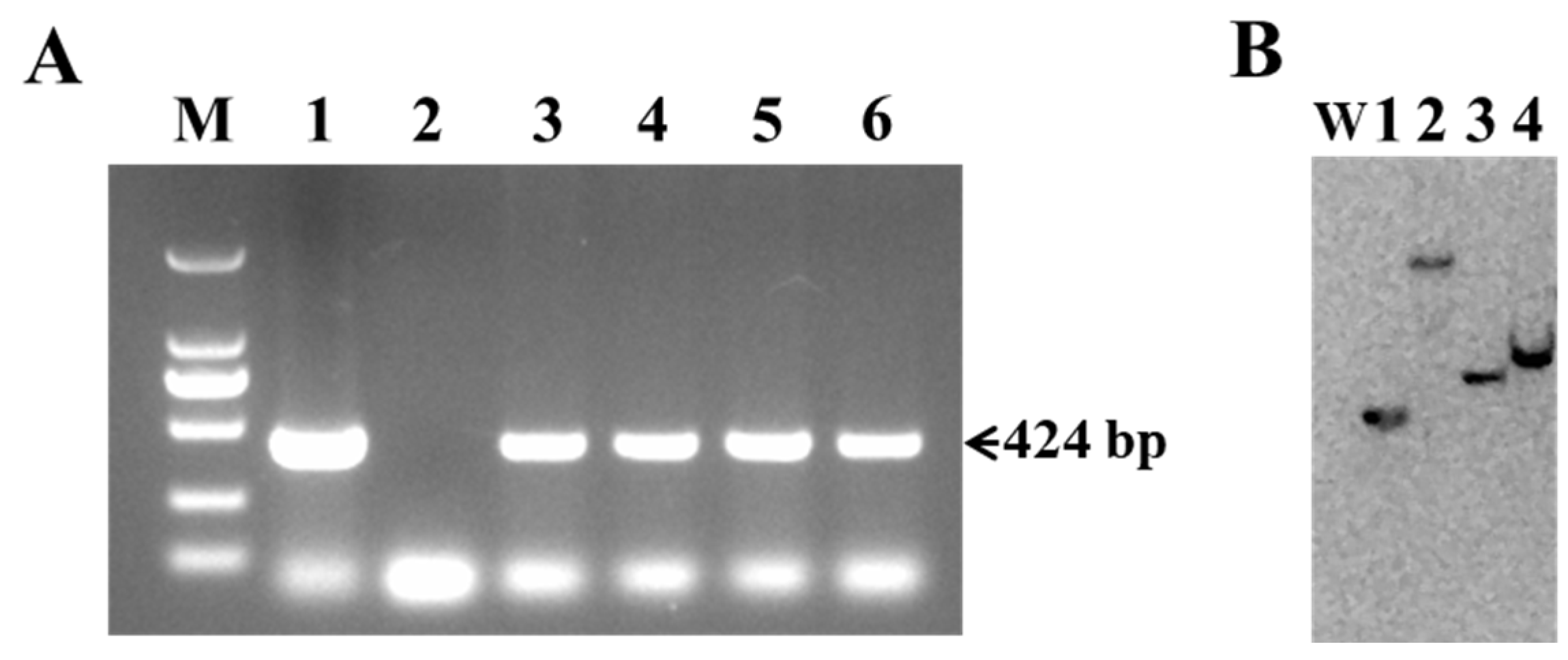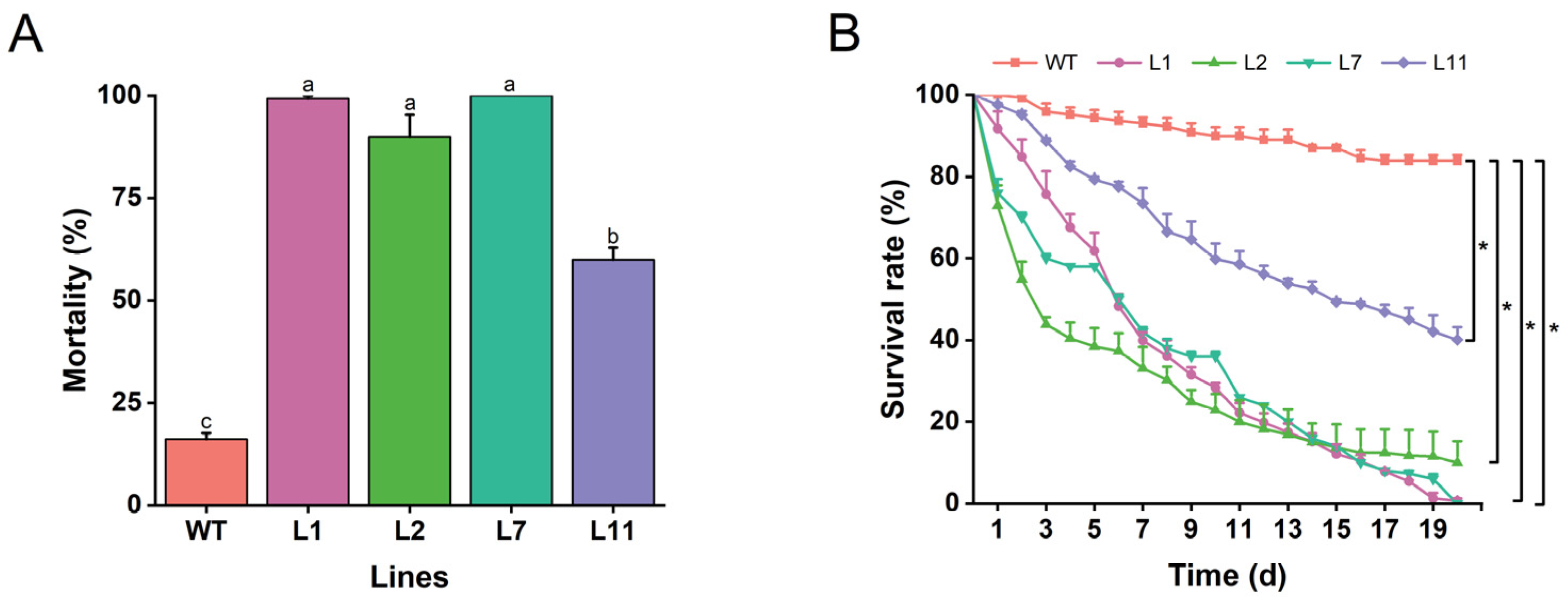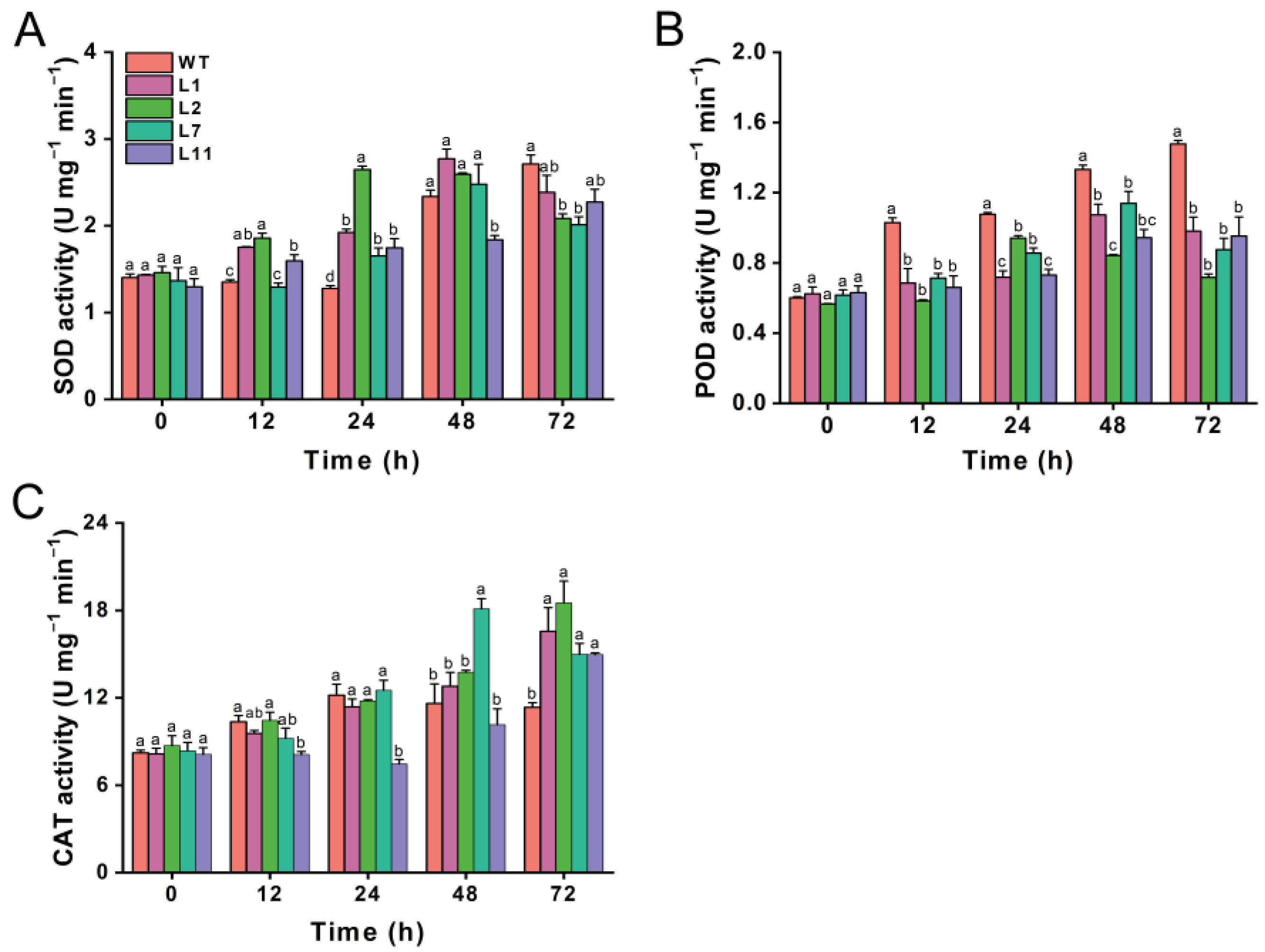Genetic Transformation of Torenia fournieri L. with the Bacillus thuringiensis Cry1Ab Gene Confers Resistance to Mythimna separata (Walker)
Abstract
1. Introduction
2. Results
2.1. Construction of Recombinant Vector pBI121-Cry1Ab
2.2. Development of Transgenic Torenia Plants
2.3. Molecular Confirmation of the Transgenic Plants
2.4. Expression Levels of Cry1Ab Gene in the Transgenic Torenia Plants
2.5. Cry1Ab Protein Abundance in Transgenic Torenia Plants
2.6. Transgenic Torenia Plants Expressing the Cry1Ab Gene Are Resistant to M. separata
2.7. Transgenic Torenia Plants Expressing the Cry1Ab Gene Affect the Activities of Protective Enzymes in M. separata
3. Discussion
4. Materials and Methods
4.1. Vector Construction
4.2. Plant Transformation
4.3. Genomic DNA Extraction and PCR Screening
4.4. Southern Blot
4.5. RNA Extraction and qRT-PCR Analysis
4.6. Detection of Cry1Ab Protein in Transgenic Plants
4.7. Insect Bioassay
4.8. Determination of Protective Enzyme Activity
4.9. Statistical Analysis
Supplementary Materials
Author Contributions
Funding
Data Availability Statement
Conflicts of Interest
References
- Mateos Fernández, R.; Petek, M.; Gerasymenko, I.; Juteršek, M.; Baebler, Š.; Kallam, K.; Moreno Giménez, E.; Gondolf, J.; Nordmann, A.; Gruden, K. Insect pest management in the age of synthetic biology. Plant Biotechnol. J. 2022, 20, 25–36. [Google Scholar] [CrossRef]
- Bonning, B.C.; Chougule, N.P. Delivery of intrahemocoelic peptides for insect pest management. Trends Biotechnol. 2014, 32, 91–98. [Google Scholar] [CrossRef] [PubMed]
- Tabashnik, B.E.; Mota-Sanchez, D.; Whalon, M.E.; Hollingworth, R.M.; Carrière, Y. Defining terms for proactive management of resistance to Bt crops and pesticides. J. Econ. Entomol. 2014, 107, 496–507. [Google Scholar] [CrossRef]
- Sharma, A.; Shukla, A.; Attri, K.; Kumar, M.; Kumar, P.; Suttee, A.; Singh, G.; Barnwal, R.P.; Singla, N. Global trends in pesticides: A looming threat and viable alternatives. Ecotox. Environ. Saf. 2020, 201, 110812. [Google Scholar] [CrossRef]
- Araújo, M.F.; Castanheira, E.M.; Sousa, S.F. The buzz on insecticides: A review of uses, molecular structures, targets, adverse effects, and alternatives. Molecules 2023, 28, 3641. [Google Scholar] [CrossRef] [PubMed]
- Smith, C.M. Conventional breeding of insect-resistant crop plants: Still the best way to feed the world population. Curr. Opin. Insect Sci. 2021, 45, 7–13. [Google Scholar] [CrossRef] [PubMed]
- Rakesh, V.; Ghosh, A. Advancements in genetically modified insect pest-resistant crops in India. Planta 2024, 260, 86. [Google Scholar] [CrossRef]
- Kumari, P.; Jasrotia, P.; Kumar, D.; Kashyap, P.L.; Kumar, S.; Mishra, C.N.; Kumar, S.; Singh, G.P. Biotechnological approaches for host plant resistance to insect pests. Front. Genet. 2022, 13, 914029. [Google Scholar] [CrossRef]
- Wani, S.H.; Choudhary, M.; Barmukh, R.; Bagaria, P.K.; Samantara, K.; Razzaq, A.; Jaba, J.; Ba, M.N.; Varshney, R.K. Molecular mechanisms, genetic mapping, and genome editing for insect pest resistance in field crops. Theor. Appl. Genet. 2022, 135, 3875–3895. [Google Scholar] [CrossRef] [PubMed]
- Gassmann, A.J.; Reisig, D.D. Management of insect pests with Bt crops in the United States. Annu. Rev. Entomol. 2023, 68, 31–49. [Google Scholar] [CrossRef]
- Arsov, A.; Gerginova, M.; Paunova-Krasteva, T.; Petrov, K.; Petrova, P. Multiple cry genes in Bacillus thuringiensis strain BTG suggest a broad-spectrum insecticidal activity. Int. J. Mol. Sci. 2023, 24, 11137. [Google Scholar] [CrossRef]
- Macedo, M.L.R.; Oliveira, C.F.; Oliveira, C.T. Insecticidal activity of plant lectins and potential application in crop protection. Molecules 2015, 20, 2014–2033. [Google Scholar] [CrossRef] [PubMed]
- Singh, S.; Singh, A.; Kumar, S.; Mittal, P.; Singh, I.K. Protease inhibitors: Recent advancement in its usage as a potential biocontrol agent for insect pest management. Insect Sci. 2020, 27, 186–201. [Google Scholar] [CrossRef] [PubMed]
- Pandey, A.; Yadav, R.; Sanyal, I. Evaluating the pesticidal impact of plant protease inhibitors: Lethal weaponry in the co-evolutionary battle. Pest Manag. Sci. 2022, 78, 855–868. [Google Scholar] [CrossRef] [PubMed]
- Kocyigit, E.; Kocaadam-Bozkurt, B.; Bozkurt, O.; Ağagündüz, D.; Capasso, R. Plant toxic proteins: Their biological activities, mechanism of action and removal strategies. Toxins 2023, 15, 356. [Google Scholar] [CrossRef]
- Li, Y.; Hallerman, E.M.; Wu, K.; Peng, Y. Insect-resistant genetically engineered crops in China: Development, application, and prospects for use. Annu. Rev. Entomol. 2020, 65, 273–292. [Google Scholar] [CrossRef]
- Nielsen-LeRoux, C.; Gaudriault, S.; Ramarao, N.; Lereclus, D.; Givaudan, A. How the insect pathogen bacteria Bacillus thuringiensis and Xenorhabdus/Photorhabdus occupy their hosts. Curr. Opin. Microbiol. 2012, 15, 220–231. [Google Scholar] [CrossRef]
- Jurat-Fuentes, J.L.; Crickmore, N. Specificity determinants for Cry insecticidal proteins: Insights from their mode of action. J. Invertebr. Pathol. 2017, 142, 5–10. [Google Scholar] [CrossRef] [PubMed]
- de Bortoli, C.P.; Jurat-Fuentes, J.L. Mechanisms of resistance to commercially relevant entomopathogenic bacteria. Curr. Opin. Insect Sci. 2019, 33, 56–62. [Google Scholar] [CrossRef] [PubMed]
- Liang, J.G.; Zhang, D.D.; Li, D.Y.; Zhao, S.Y.; Wang, C.Y.; Xiao, Y.T.; Dong, X.; Yang, Y.Z.; Li, G.P.; Wang, L.L. Expression profiles of Cry1Ab protein and its insecticidal efficacy against the invasive fall armyworm for Chinese domestic GM maize DBN9936. J. Integr. Agric. 2021, 20, 792–803. [Google Scholar] [CrossRef]
- Carrière, Y.; Crickmore, N.; Tabashnik, B.E. Optimizing pyramided transgenic Bt crops for sustainable pest management. Nat. Biotechnol. 2015, 33, 161–168. [Google Scholar] [CrossRef] [PubMed]
- Xiao, Y.; Wu, K. Recent progress on the interaction between insects and Bacillus thuringiensis crops. Philos. Trans. R. Soc. B 2019, 374, 20180316. [Google Scholar] [CrossRef] [PubMed]
- Nishihara, M.; Shimoda, T.; Nakatsuka, T.; Arimura, G. Frontiers of torenia research: Innovative ornamental traits and study of ecological interaction networks through genetic engineering. Plant Methods 2013, 9, 23. [Google Scholar] [CrossRef] [PubMed]
- Guan, S.; Song, Q.; Zhou, J.; Yan, H.; Li, Y.; Zhang, Z.; Tao, D.; Luo, S.; Pan, Y. Genetic analysis and population structure of wild and cultivated wishbone flower (Torenia fournieri Lind.) lines related to specific floral color. PeerJ 2021, 9, e11702. [Google Scholar] [CrossRef] [PubMed]
- Zhang, L.; Yung, W.-S.; Wang, Z.; Li, M.-W.; Huang, M. Optimization of an efficient protoplast transformation system for transient expression analysis using leaves of Torenia fournieri. Plants 2022, 11, 2106. [Google Scholar] [CrossRef]
- Aida, R. Torenia fournieri (torenia) as a model plant for transgenic studies. Plant Biotechnol. 2008, 25, 541–545. [Google Scholar] [CrossRef]
- Aida, R. Aida, R. A protocol for transformation of Torenia. In Transgenic Plants: Methods and Protocols; Springer: Berlin/Heidelberg, Germany, 2012; pp. 267–274. [Google Scholar]
- Nishihara, M.; Higuchi, A.; Watanabe, A.; Tasaki, K. Application of the CRISPR/Cas9 system for modification of flower color in Torenia fournieri. BMC Plant Biol. 2018, 18, 331. [Google Scholar] [CrossRef] [PubMed]
- Chandler, S.F.; Sanchez, C. Genetic modification; the development of transgenic ornamental plant varieties. Plant Biotechnol. J. 2012, 10, 891–903. [Google Scholar] [CrossRef]
- Nishihara, M.; Hirabuchi, A.; Teshima, T.; Uesugi, S.; Takahashi, H. Flower color modification in Torenia fournieri by genetic engineering of betacyanin pigments. BMC Plant Biol. 2024, 24, 614. [Google Scholar] [CrossRef]
- Xiao, W.; Su, S.; Higashiyama, T.; Luo, D. A homolog of the ALOG family controls corolla tube differentiation in Torenia fournieri. Development 2019, 146, dev177410. [Google Scholar] [CrossRef]
- Su, S.; Lei, Y.; Zhou, X.; Suzuki, T.; Xiao, W.; Higashiyama, T. A BLADE-ON-PETIOLE orthologue regulates corolla differentiation in the proximal region in Torenia fournieri. Nat. Commun. 2023, 14, 4763. [Google Scholar] [CrossRef]
- Muroi, A.; Matsui, K.; Shimoda, T.; Kihara, H.; Ozawa, R.; Ishihara, A.; Nishihara, M.; Arimura, G. Acquired immunity of transgenic torenia plants overexpressing agmatine coumaroyltransferase to pathogens and herbivore pests. Sci. Rep. 2012, 2, 689. [Google Scholar] [CrossRef] [PubMed]
- Shimoda, T.; Nishihara, M.; Ozawa, R.; Takabayashi, J.; Arimura, G.i. The effect of genetically enriched (E)-β-ocimene and the role of floral scent in the attraction of the predatory mite Phytoseiulus persimilis to spider mite-induced volatile blends of torenia. New Phytol. 2012, 193, 1009–1021. [Google Scholar] [CrossRef] [PubMed]
- Azadi, P.; Bagheri, H.; Nalousi, A.M.; Nazari, F.; Chandler, S.F. Current status and biotechnological advances in genetic engineering of ornamental plants. Biotechnol. Adv. 2016, 34, 1073–1090. [Google Scholar] [CrossRef] [PubMed]
- Zhang, Z.; Yang, X.; Wang, W.; Wu, K. Insecticidal effects of transgenic maize Bt-Cry1Ab, Bt-Vip3Aa, and Bt-Cry1Ab+ Vip3Aa against the oriental armyworm, Mythimna separata (Walker) in southwest China. Toxins 2024, 16, 134. [Google Scholar] [CrossRef] [PubMed]
- Bhat, A.A.; Tak, H.; Ahad, I.; War, W.A.; Rasool, J.; Sheikh, S.A.; Malik, I.M. Unveiling the impact of Mythimna seperata Walker (Lepidoptera: Noctuidae) on agriculture: Insights into host range biology and biological control: A review. J. Exp. Agric. Int. 2024, 46, 248–261. [Google Scholar] [CrossRef]
- Jiang, X.F.; Luo, L.Z.; Zhang, L.; Sappington, T.W.; Hu, Y. Regulation of migration in Mythimna separata (Walker) in China: A review integrating environmental, physiological, hormonal, genetic, and molecular factors. Environ. Entomol. 2011, 40, 516–533. [Google Scholar] [CrossRef] [PubMed]
- Liu, Q.; Hallerman, E.; Peng, Y.; Li, Y. Development of Bt rice and Bt maize in China and their efficacy in target pest control. Int. J. Mol. Sci. 2016, 17, 1561. [Google Scholar] [CrossRef] [PubMed]
- Omer, A.; Granett, J.; Dandekar, A.; Driver, J.; Uratsu, S.; Tang, F. Effects of transgenic petunia expressing Bacillus thuringiensis toxin on selected lepidopteran pests. Biocontrol Sci. Technol. 1997, 7, 437–448. [Google Scholar] [CrossRef]
- Shinoyama, H.; Mochizuki, A.; Komano, M.; Nomura, Y.; Nagai, T. Insect resistance in transgenic chrysanthemum [Dendranthema × grandiflorum (Ramat.) Kitamura] by the introduction of a modified δ-endotoxin gene of Bacillus thuringiensis. Breed. Sci. 2003, 53, 359–367. [Google Scholar] [CrossRef][Green Version]
- Shinoyama, H.; Komano, M.; Nomura, Y.; Nagai, T. Introduction of delta-endotoxin gene of Bacillus thuringiensis to chrysanthemum [Dendranthema × grandiflorum (Ramat.) Kitamura] for insect resistance. Breed. Sci. 2002, 52, 43–50. [Google Scholar] [CrossRef][Green Version]
- Soh, H.S.; Han, Y.H.; Lee, G.Y.; Lim, J.W.; Yi, B.Y.; Lee, Y.H.; Choi, G.W.; Park, Y.D. Transformation of Chrysanthemum morifolium with insecticidal gene (Cry1Ac) to develop pest resistance. Hortic. Environ. Biotechnol. 2009, 50, 57–62. [Google Scholar]
- Park, J.; Lee, Y.K.; Kang, B.K.; Chung, W.I. Co-transformation using a negative selectable marker gene for the production of selectable marker gene-free transgenic plants. Theor. Appl. Genet. 2004, 109, 1562–1567. [Google Scholar] [CrossRef]
- Vidal, J.; Kikkert, J.; Wallace, P.; Reisch, B. High-efficiency biolistic co-transformation and regeneration of ’Chardonnay’ (Vitis vinifera L.) containing npt-II and antimicrobial peptide genes. Plant Cell Rep. 2003, 22, 252–260. [Google Scholar] [CrossRef]
- Aida, R.; Yoshida, T.; Ichimura, K.; Goto, R.; Shibata, M. Extension of flower longevity in transgenic torenia plants incorporating ACC oxidase transgene. Plant Sci. 1998, 138, 91–101. [Google Scholar] [CrossRef]
- Sasaki, K.; Ohtsubo, N. Production of multi-petaled Torenia fournieri flowers by functional disruption of two class-C MADS-box genes. Planta 2020, 251, 101. [Google Scholar] [CrossRef]
- Sekiguchi, N.; Sasaki, K.; Oshima, Y.; Mitsuda, N. Ectopic expression of AtNF-YA6-VP16 in petals results in a novel petal phenotype in Torenia fournieri. Planta 2022, 255, 105. [Google Scholar] [CrossRef] [PubMed]
- Chen, L.; Kuai, P.; Ye, M.; Zhou, S.; Lu, J.; Lou, Y. Overexpression of a cytosolic 6-phosphogluconate dehydrogenase gene enhances the resistance of rice to Nilaparvata lugens. Plants 2020, 9, 1529. [Google Scholar] [CrossRef] [PubMed]
- Ribeiro, T.P.; Arraes, F.B.M.; Lourenço-Tessutti, I.T.; Silva, M.S.; Lisei-de-Sá, M.E.; Lucena, W.A.; Macedo, L.L.P.; Lima, J.N.; Santos Amorim, R.M.; Artico, S. Transgenic cotton expressing Cry10Aa toxin confers high resistance to the cotton boll weevil. Plant Biotechnol. J. 2017, 15, 997–1009. [Google Scholar] [CrossRef] [PubMed]
- Kumar, A.; Jaiwal, R.; Sreevathsa, R.; Chaudhary, D.; Jaiwal, P.K. Transgenic cowpea plants expressing Bacillus thuringiensis Cry2Aa insecticidal protein imparts resistance to Maruca vitrata legume pod borer. Plant Cell Rep. 2021, 40, 583–594. [Google Scholar] [CrossRef]
- Nishihara, M.; Yamada, E.; Saito, M.; Fujita, K.; Takahashi, H.; Nakatsuka, T. Molecular characterization of mutations in white-flowered torenia plants. BMC Plant Biol. 2014, 14, 86. [Google Scholar] [CrossRef]
- Yu, H.; Li, Y.; Li, X.; Romeis, J.; Wu, K. Expression of Cry1Ac in transgenic Bt soybean lines and their efficiency in controlling lepidopteran pests. Pest Manag. Sci. 2013, 69, 1326–1333. [Google Scholar] [CrossRef]
- Jurat-Fuentes, J.L.; Heckel, D.G.; Ferré, J. Mechanisms of resistance to insecticidal proteins from Bacillus thuringiensis. Annu. Rev. Entomol. 2021, 66, 121–140. [Google Scholar] [CrossRef] [PubMed]
- Sanahuja, G.; Banakar, R.; Twyman, R.M.; Capell, T.; Christou, P. Bacillus thuringiensis: A century of research, development and commercial applications. Plant Biotechnol. J. 2011, 9, 283–300. [Google Scholar] [CrossRef]
- Sena da Silva, I.H.; Gómez, I.; Pacheco, S.; Sánchez, J.; Zhang, J.; Luque Castellane, T.C.; Aparecida Desiderio, J.; Soberón, M.; Bravo, A.; Polanczyk, R.A. Bacillus thuringiensis Cry1Ab domain III β-16 is involved in binding to prohibitin, which correlates with toxicity against Helicoverpa armigera (Lepidoptera: Noctuidae). Appl. Environ. Microb. 2021, 87, e01930-20. [Google Scholar] [CrossRef] [PubMed]
- Wang, Y.; Zhao, W.; Han, S.; Wang, L.; Chang, X.; Liu, K.; Quan, Y.; Wang, Z.; He, K. Seven years of monitoring susceptibility to Cry1Ab and Cry1F in Asian corn borer. Toxins 2023, 15, 137. [Google Scholar] [CrossRef]
- Gómez, I.; Ocelotl, J.; Sánchez, J.; Lima, C.; Martins, E.; Rosales-Juárez, A.; Aguilar-Medel, S.; Abad, A.; Dong, H.; Monnerat, R. Enhancement of Bacillus thuringiensis Cry1Ab and Cry1Fa toxicity to Spodoptera frugiperda by domain III mutations indicates there are two limiting steps in toxicity as defined by receptor binding and protein stability. Appl. Environ. Microb. 2018, 84, e01393-18. [Google Scholar] [CrossRef]
- Jiao, Y.; Yang, Y.; Meissle, M.; Peng, Y.; Li, Y. Comparison of susceptibility of Chilo suppressalis and Bombyx mori to five Bacillus thuringiensis proteins. J. Invertebr. Pathol. 2016, 136, 95–99. [Google Scholar] [CrossRef] [PubMed]
- Su, H.H.; Jiang, T.; Yu, S.; Gu, H.J.; Wu, J.J.; Yang, Y.Z. Effect of three insect-resistant maizes expressing Cry1Ie, Cry1Ab/Cry2Aj and Cry1Ab on the growth and development of armyworm Mythimna separata (Walker). J. Integr. Agric. 2020, 19, 1842–1849. [Google Scholar] [CrossRef]
- Siebert, M.W.; Babock, J.; Nolting, S.; Santos, A.; Adamczyk Jr, J.; Neese, P.; King, J.; Jenkins, J.; McCarty, J.; Lorenz, G. Efficacy of Cry1F insecticidal protein in maize and cotton for control of fall armyworm (Lepidoptera: Noctuidae). Fla. Entomol. 2008, 91, 555–565. [Google Scholar]
- Pinos, D.; Andrés-Garrido, A.; Ferré, J.; Hernández-Martínez, P. Response mechanisms of invertebrates to Bacillus thuringiensis and its pesticidal proteins. Microbiol. Mol. Biol. Rev. 2021, 85, e00007–e00020. [Google Scholar] [CrossRef] [PubMed]
- Xiao, Z.; Yao, X.; Bai, S.; Wei, J.; An, S. Involvement of an enhanced immunity mechanism in the resistance to Bacillus thuringiensis in Lepidopteran Pests. Insects 2023, 14, 151. [Google Scholar] [CrossRef] [PubMed]
- Li, J.; Guo, Q.; Yang, B.; Zhou, J. Combined analysis of metabolomics and transcriptome revealed the effect of Bacillus thuringiensis on the 5th instar larvae of Dendrolimus kikuchii Matsumura. Int. J. Mol. Sci. 2024, 25, 11823. [Google Scholar] [CrossRef]
- Xie, N.; Jiang, X.F.; Luo, L.Z.; Zhang, L. Effects of Cry1Ac toxin on activities of some enzymes in the larval midgut of the oriental armyworm, Mythimna separata (Lepidoptera: Noctuidae). Acta Entomol. Sin. 2012, 55, 168–175. [Google Scholar]
- Xu, X.; Liang, X.; Wei, W.; Ding, X.; Peng, C.; Wang, X.; Chen, X.; Yang, L.; Xu, J. Effects of non-lethal Cry1F toxin exposure on the growth, immune response, and intestinal microbiota of silkworm (Bombyx mori). Ecotox. Environ. Saf. 2023, 267, 115648. [Google Scholar] [CrossRef] [PubMed]
- Yang, Y.; Xu, H.; Lu, Y.; Wang, C.; Lu, Z. Midgut transcriptomal response of the rice leaffolder, Cnaphalocrocis medinalis (Guenée) to Cry1C toxin. PLoS ONE 2018, 13, e0191686. [Google Scholar] [CrossRef]
- Ren, X.; Wang, Y.; Ma, Y.; Jiang, W.; Ma, X.; Hu, H.; Wang, D.; Ma, Y. Midgut de novo transcriptome analysis and gene expression profiling of Spodoptera exigua larvae exposed with sublethal concentrations of Cry1Ca protein. 3 Biotech 2020, 10, 138. [Google Scholar] [CrossRef] [PubMed]
- Holsters, M.; De Waele, D.; Depicker, A.; Messens, E.; Van Montagu, M.; Schell, J. Transfection and transformation of Agrobacterium tumefaciens. Mol. Gen. Gen. 1978, 163, 181–187. [Google Scholar] [CrossRef]
- Porebski, S.; Bailey, L.G.; Baum, B.R. Modification of a CTAB DNA extraction protocol for plants containing high polysaccharide and polyphenol components. Plant Mol. Biol. Rep. 1997, 15, 8–15. [Google Scholar] [CrossRef]
- Schmittgen, T.D.; Livak, K.J. Analyzing real-time PCR data by the comparative CT method. Nat. Protoc. 2008, 3, 1101–1108. [Google Scholar] [CrossRef]







Disclaimer/Publisher’s Note: The statements, opinions and data contained in all publications are solely those of the individual author(s) and contributor(s) and not of MDPI and/or the editor(s). MDPI and/or the editor(s) disclaim responsibility for any injury to people or property resulting from any ideas, methods, instructions or products referred to in the content. |
© 2024 by the authors. Licensee MDPI, Basel, Switzerland. This article is an open access article distributed under the terms and conditions of the Creative Commons Attribution (CC BY) license (https://creativecommons.org/licenses/by/4.0/).
Share and Cite
Chen, L.; Wang, P.; Tan, L.; Li, H.; Wang, D. Genetic Transformation of Torenia fournieri L. with the Bacillus thuringiensis Cry1Ab Gene Confers Resistance to Mythimna separata (Walker). Plants 2024, 13, 3568. https://doi.org/10.3390/plants13243568
Chen L, Wang P, Tan L, Li H, Wang D. Genetic Transformation of Torenia fournieri L. with the Bacillus thuringiensis Cry1Ab Gene Confers Resistance to Mythimna separata (Walker). Plants. 2024; 13(24):3568. https://doi.org/10.3390/plants13243568
Chicago/Turabian StyleChen, Lin, Pei Wang, Lixia Tan, Houhua Li, and Dun Wang. 2024. "Genetic Transformation of Torenia fournieri L. with the Bacillus thuringiensis Cry1Ab Gene Confers Resistance to Mythimna separata (Walker)" Plants 13, no. 24: 3568. https://doi.org/10.3390/plants13243568
APA StyleChen, L., Wang, P., Tan, L., Li, H., & Wang, D. (2024). Genetic Transformation of Torenia fournieri L. with the Bacillus thuringiensis Cry1Ab Gene Confers Resistance to Mythimna separata (Walker). Plants, 13(24), 3568. https://doi.org/10.3390/plants13243568






